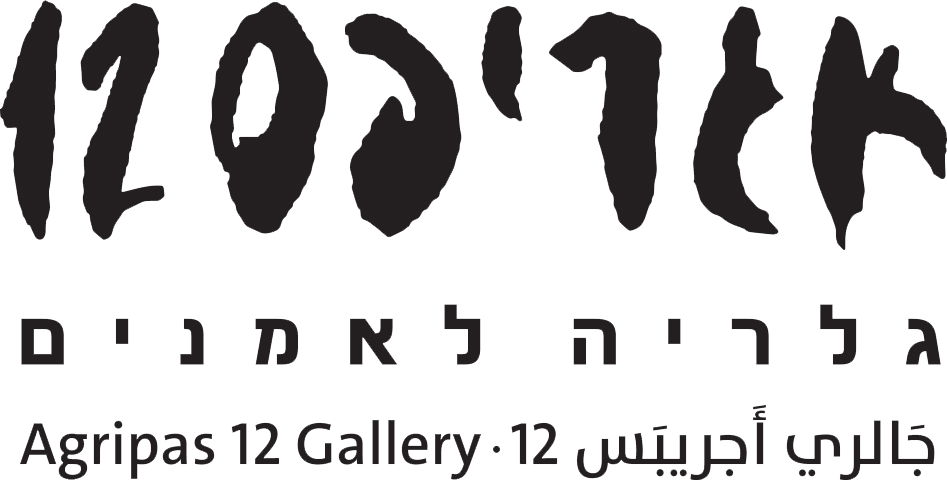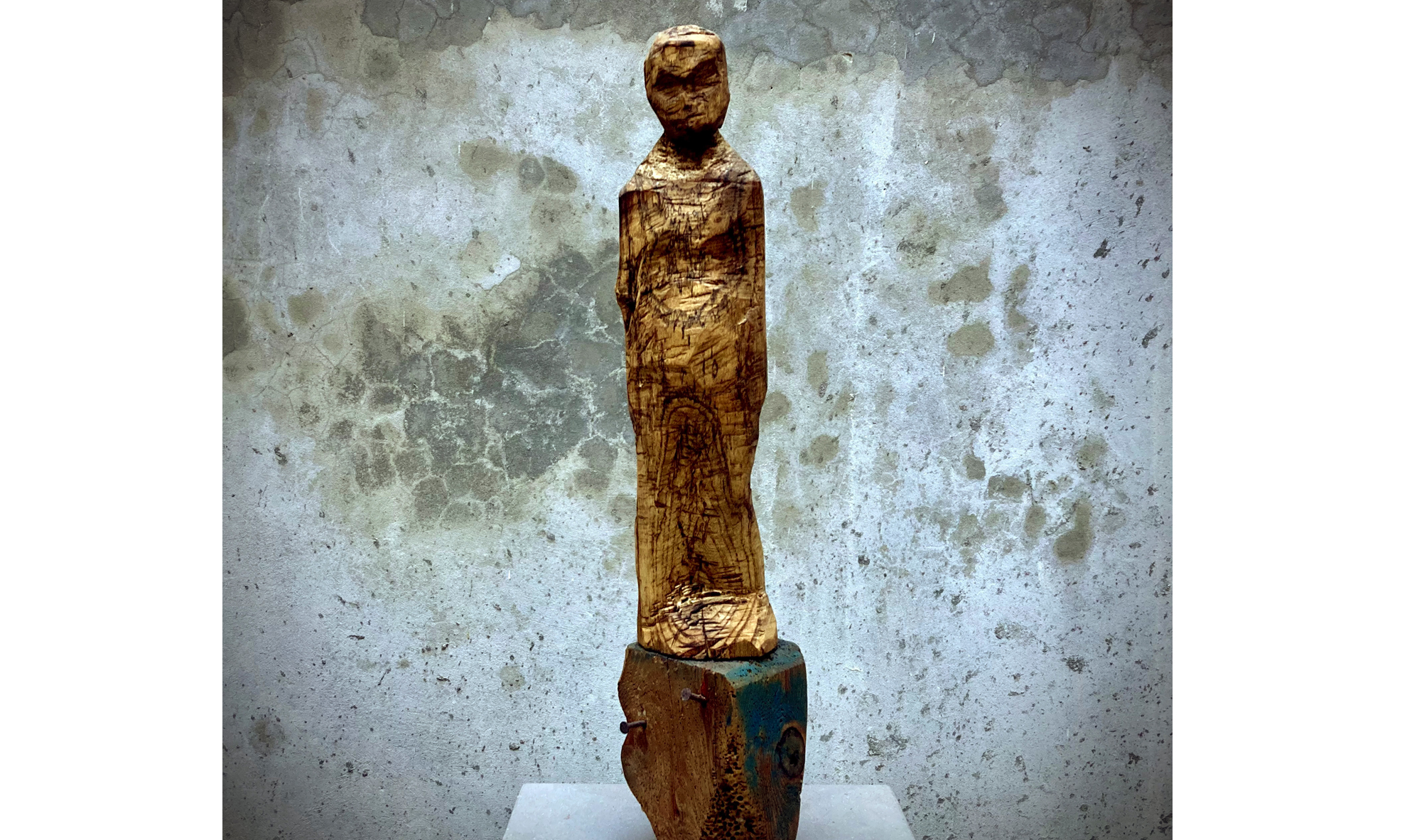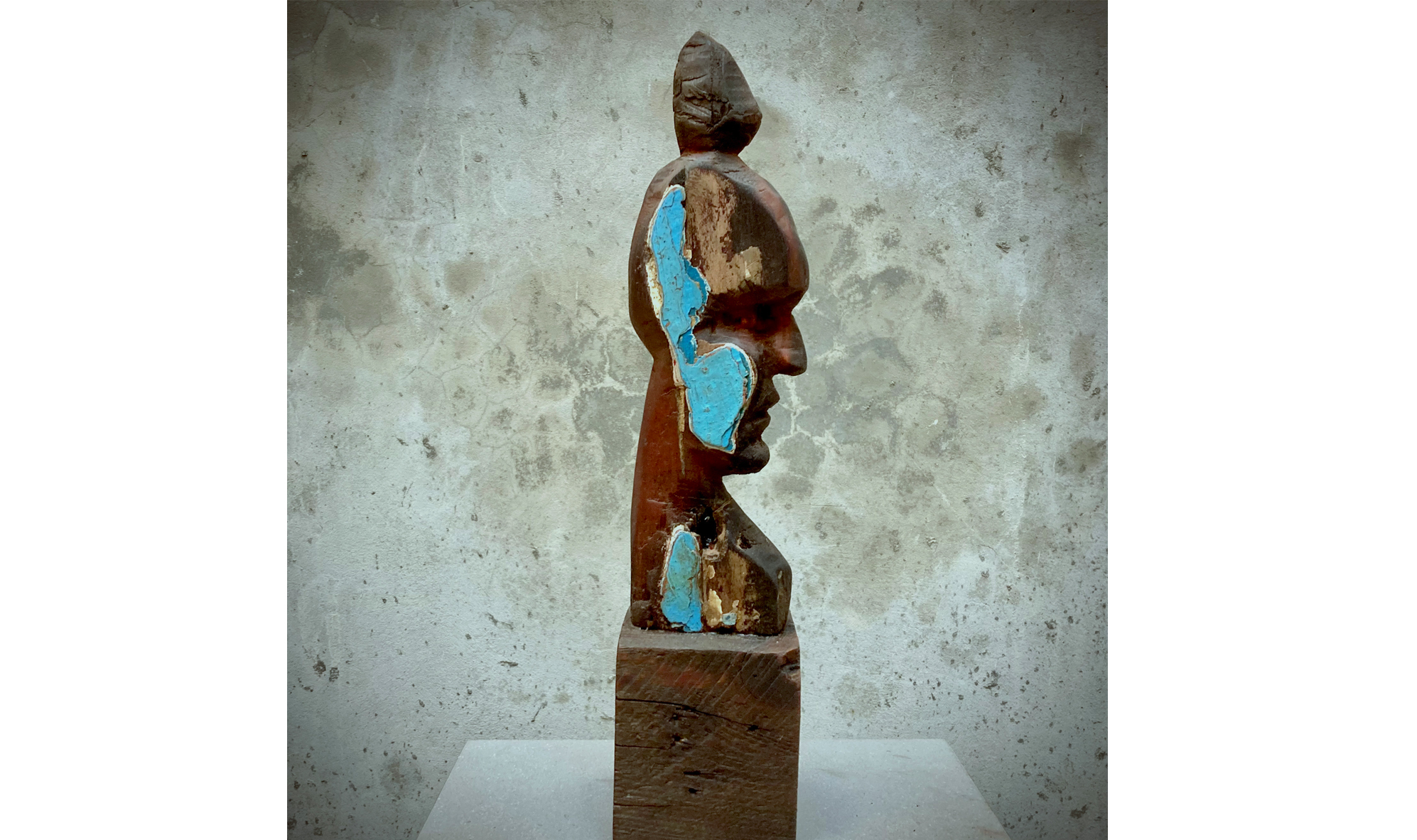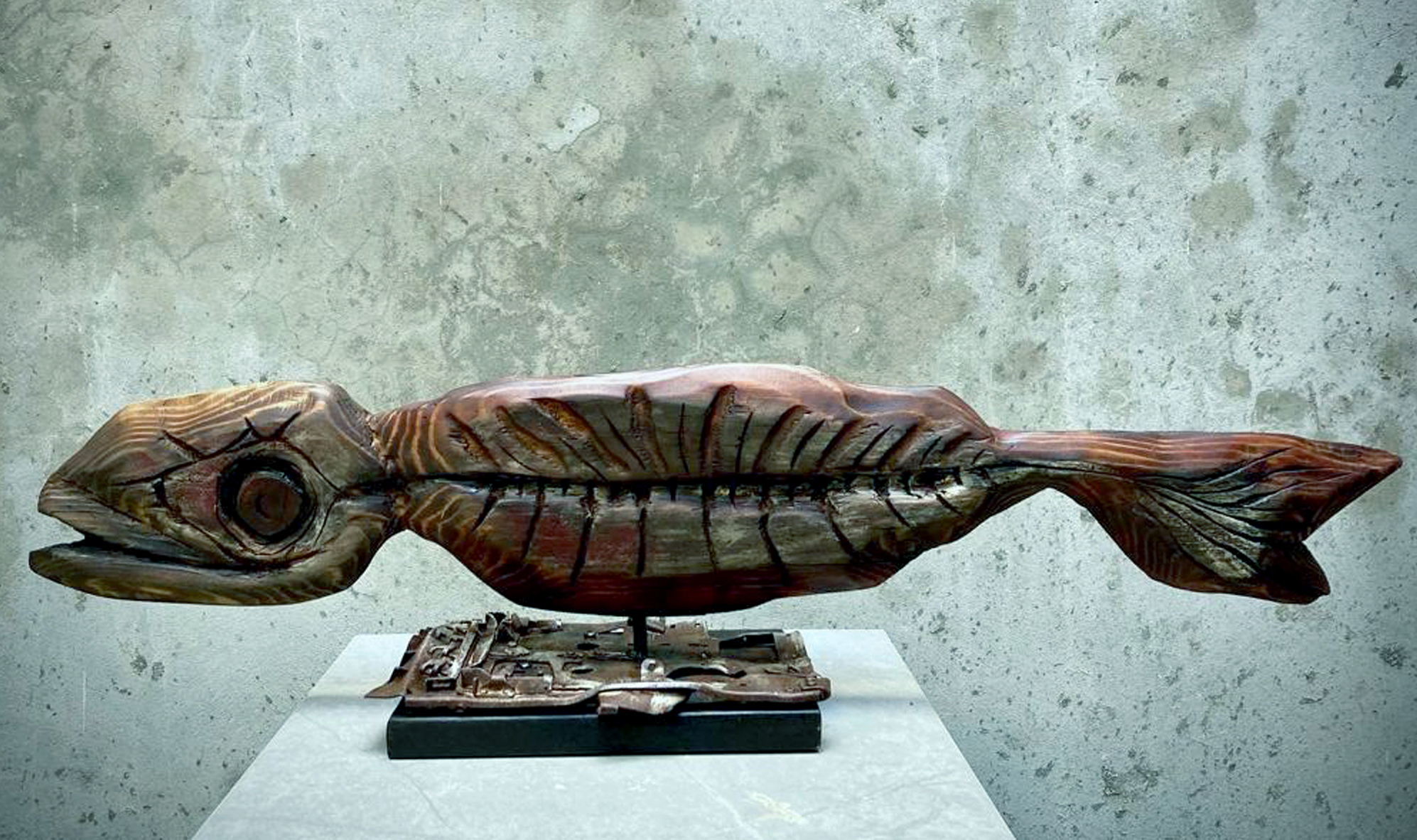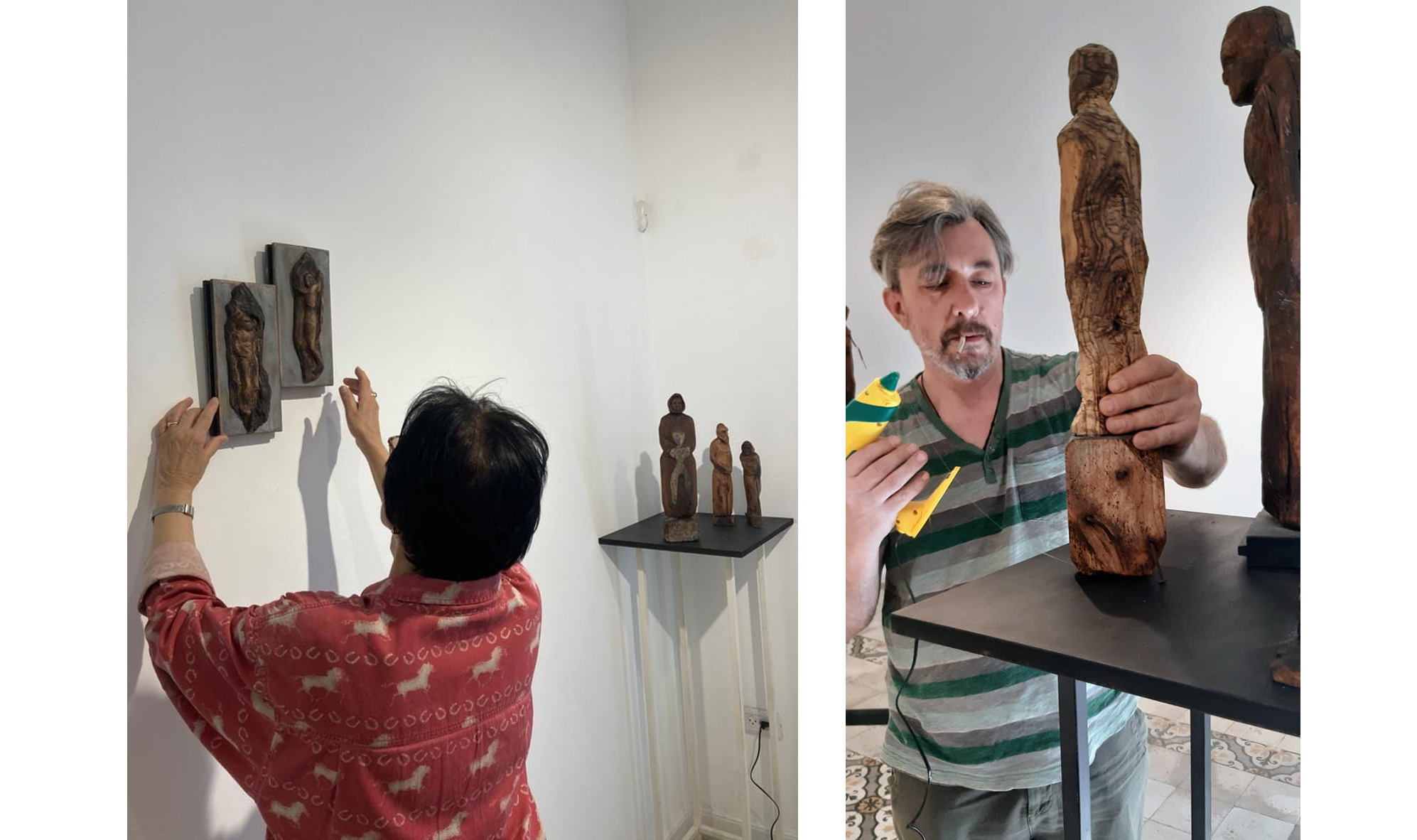
מקס אפשטיין / נסחפים
אוצרת: רינה פלד
פתיחה: 8.4.2022 | נעילה: 7.5.2022
English text after Hebrew
*הצילום למעלה: מקס אפשטיין, Fish2b
נסחפים
מקס אפשטיין – אמן בין-תחומי: הוא עוסק ברישום, ציור, פיסול, צילום ואנימציה. ההפרדה בין המדיה השונים איננה מוחלטת. הם חודרים אחד לשני ומזינים אחד את השני.
גם בין החיים לאמנות קשה למצוא אצלו הפרדה מוחלטת: החיים הם מעשה אמנות, והאמנות היא החיים. די לבקר בסטודיו שלו כדי להבין זאת – הסטודיו איננו תחום בחלל אחד, אלא ״משתלט״ למעשה על הבית כולו.
אפיון נוסף שלו כאדם וכאמן הוא מעשה האספנות. מקס כמעט איננו רושם/מצייר/מפסל על ״לוח חלק״. הוא משוטט במרחב העירוני ובטבע, מוצא אובייקטים שונים: גזעי עצים, ספרים ישנים, חפצים זרוקים, יומנים וכיו״ב ואלו משמשים מצע לאמנות שלו.
מוצגת סדרת פסלים שנעשו כולם מגזעי עצים שנסחפו – Driftwoo – בתערוכה שלפנינו: נסחפים אל חוף הים. תהליך העבודה של מקס מתחיל בשיטוט ההרפתקני שלו על שפת הים. הוא מחפש את חלקי העצים שנסחפו אל החוף (מהיכן הגיעו? איזה מרחק הם עברו עד שנסחפו? האם אלו חלקי ספינה טרופה?…) אוסף את אלו שהוא מסוגל להעמיס על ידיו, מביא אותם אל הסטודיו שלו, ושם יוצר מהם את פסליו.
צורתו הגולמית של העץ המצוי ״מכתיבה״ את דמותו ואת מימדיו של הפסל הסופי: מקס כאילו חושף בעבודתו את הדמות החבוייה בתוך גזע העץ, מוציא מן הכוח אל הפועל את מה שגלום בתוך העץ.
(כשמקס מתאר את תהליך עבודתו, אי אפשר שלא לחשוב על מיכלאנג'לו, שטען שבעבודתו הוא תמיד רק חושף את הדמות החבוייה בתוך גוש השיש).
סוג העץ )אורן, אלון, אגוז מלך, דובדבן, משמש, העץ האדום, אשור, אדר, אקליפטוס, לרוב עצים ״לא מקומיים״ שהגיעו מרחוק(, הטקסטורה שלו, צבעו, מידת הקושי שלו, מימדיו ועוד, קובעים את צורתו הסופית של הפסל. מקס מגלף את פסליו בעזרת גרזן, כשהוא משאיר את עקבות הכלי בפסלים ״המוגמרים״: פני השטח שלהם אינם חלקים בדרך כלל, הטקסטורה שלהם גסה ומחוספסת, והם לכאורה, ״בלתי גמורים״. פה ושם מופיעים על הפסלים גם שכבות של שרידי צבע שנשארו מצביעות קודמות על גזעי העץ המקוריים, ולעתים מקס מעצים אותם.
מבחינה צורנית ותוכנית כאחד, ניתן לחלק את הפסלים בתערוכה לשלוש סדרות:
א. ראשים
ב. פיגורות
ג. דגים.
המיצב בחלל הגלריה הופך לסוג של מחזה תיאטרון: בחדר הראשון – במבוא – אנו נכנסים בעזרת הראשים האקספרסיביים המוצבים במעגל להלך הרוח של התערוכה כולה. הדיוקנאות אותם פוגשים הצופים, מתארות את המצב הפסיכולוגי העכשווי. אלו ״מתכתבות״ עם חדר הדיוקנאות של מחלות פסיכיאטריות מהמאה ה-18 המוצגות במוזיאון הבלוודר בווינה. בחדר השני מתגלה לפנינו חיזיון תיאטרלי, כאשר על "הבמה המרכזית" נמצאים הדגים. מבחינת מקס הדגים הם הפסלים היחידים בתערוכה המסמלים את השחייה/ההיסחפות. הם מהווים גם סמל להישרדות בזמן מבול וסערה. מסביב להם ניצבים הנשים והגברים הצופים בהם ואנחנו – המבקרים בתערוכה הופכים לצופים של כל המחזה הדיסטופי הזה.
את ה״נסחפים״ ניתן לפרש כמטפורה למצב האנושי העכשווי. הדמויות נראות כנועות, מפוחדות, כבדות, אטומות, מהורהרות. הן מצויות ברגע מסוים של לפני או אחרי התקף חרדה, ומציעות לנו מבט מסויים אל ההווה ו/או אל העתיד הנתון במשבר. התערוכה כולה מהדהדת את סימני השאלה, את העדר הביטחון שכולנו חווים בשנתיים האחרונות. משבר שהחל עם פלישת נגיף הקורונה לחיינו, הנדחקת לאחרונה לשוליים, בגלל המלחמה חסרת הפשר המתחוללת על אדמת אירופה.
ה"נסחפים" הם במובן מסוים הפליטים הנעקרים/נסחפים מבתיהם הבטוחים ונעים חסרי ישע אל עבר הלא נודע, כמו עצי הסחף שנעו במרחבי האוקיינוסים והימים עד שנחתו על החוף, והפכו לחומר גלם בידיו של הפסל.
רינה פלד, אוצרת
Driftwood
Max Epstein – interdisciplinary artist, who engages in drawing, painting, sculpture, photography, and animation. The separation between the various media is not absolute, they permeate and nourish each other. Even between life and art it is difficult to find in Max a complete separation: life is an act of art, and art is life. It is enough to visit his studio to understand this – the studio is not limited to one space, but in fact it "takes over" the entire house.
Another characterization of Max as a person and as an artist is his act of collecting. Max seldom draws / paints / sculpts on a “clean board”. He wanders through the urban space and nature, finding various objects: tree trunks, old books, discarded possessions, diaries, etc. that serve as a substrate for his art.
A series of sculptures, all made from driftwood that was swept onto the beach, is on display in this exhibition. Max's work process begins with his adventurous stroll by the sea, looking for pieces of wood that drifted to the shore. Where did they come from? What distance did they travel before they were swept up here? Are they the remains of a shipwreck? He collects the ones he can carry, brings them to his studio, and transforms them into his sculptures.
The raw shape of the existing wood "dictates" the figure and dimensions of the final sculpture: as if Max is revealing in his work the figure hidden within the piece of wood, bringing out what is embodied within the wood. When Max describes his work process, it is impossible not to think of Michelangelo, who claimed that in his work he only revealed the hidden figure inside the marble block.
The type of wood – pine, oak, walnut, cherry, apricot, redwood, beech, maple, eucalyptus, mostly from trees that are not local and come from afar – its texture, color, hardness, dimension and more, determine the final shape of the sculpture. Max carves his sculptures with an ax, leaving traces of the tool in the "finished" sculptures: their surface is usually not smooth, their texture is rough and jagged, and they are seemingly "unfinished." Here and there, layers of paint appear on the sculptures, remnants from previous coats of paint on the original wood, and sometimes Max complements, strengthens them.
In terms of both form and content, the sculptures in the exhibition can be divided into three series:
A. Heads
B. Figures
C. Fish
The installation in the gallery space becomes a kind of theatrical play: in the first room – the opening act – we enter through the expressive heads placed in a circle, auguring the mood of the entire exhibition. The portraits that the viewers encounter describe our current psychological state. They are in dialogue with the portrait room of 18th-century psychiatric illnesses on display at the Belvedere Museum in Vienna.
In the second room the theatrical spectacle is revealed before us, with the fish on the "main stage". For Max the fish are the only sculptures in the exhibition that symbolize swimming / drifting. They are also a symbol of survival during a flood and storm. Around them stand the women and men watching them and we – the visitors to the exhibition – become spectators of this whole dystopian play.
“Driftwood” can be interpreted as a metaphor for the current human condition. The characters look submissive, frightened, heavy, opaque, pensive. They are present at a particular moment before or after an anxiety attack and offer us a certain view of the present and/or the future in crisis. The entire exhibition resonates with question marks, the lack of security we have all experienced in the last two years, a crisis that began with the invasion of the corona virus into our lives, that was recently pushed to the margins, because of the meaningless war taking place on the earth of Europe. The "driftwood" are in a sense the displaced / swept away refugees from their safe and secure homes, and who drift helplessly towards the unknown, like the swept away trees that roamed the oceans and seas until they landed on the shore and became raw material in the hands of the sculptor.
Rina Peled, curator

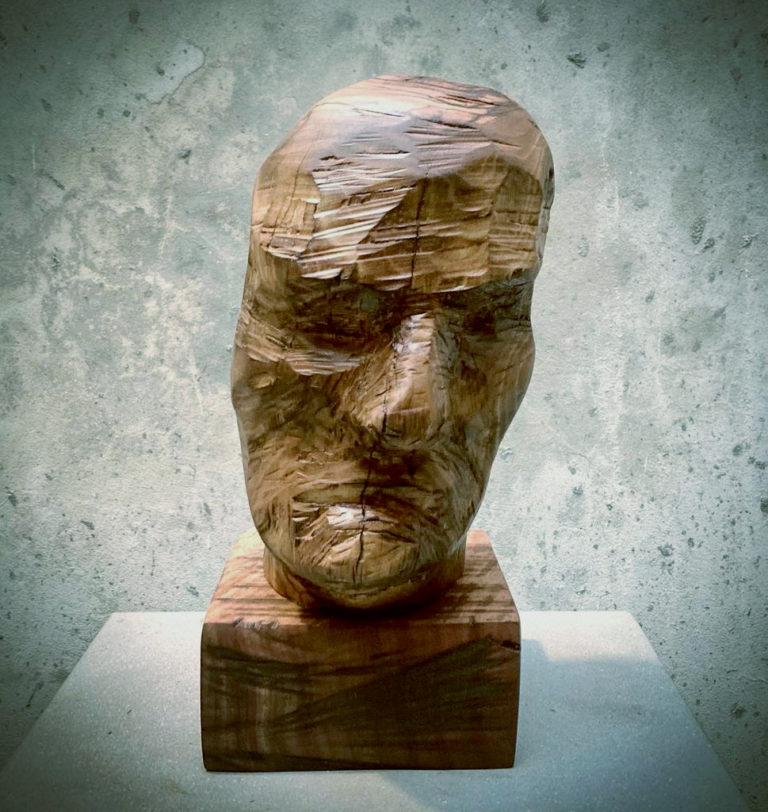
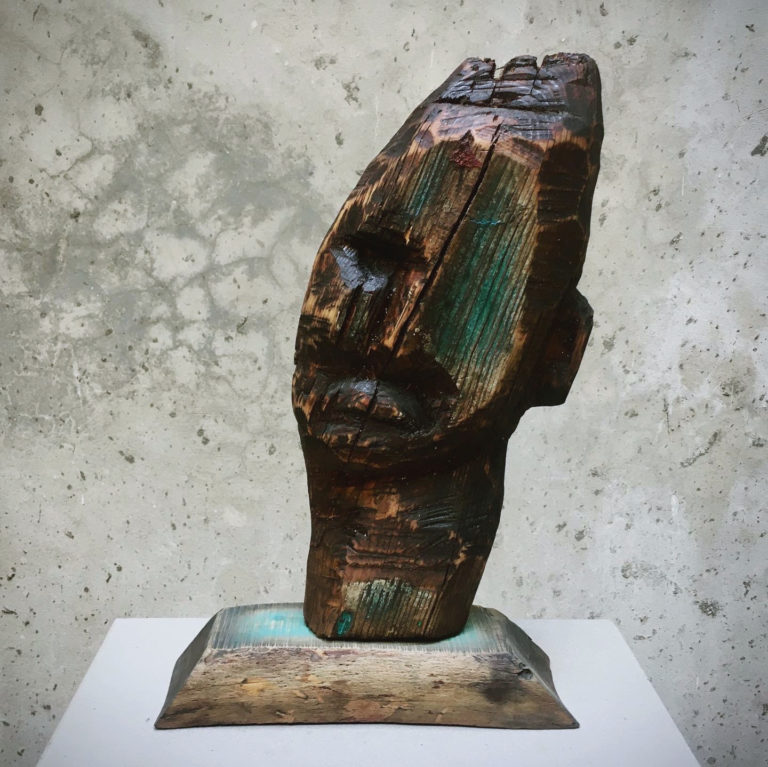
מתוך פתיחת התערוכה: נאוֹפּוסטיזם? נֶאוֹסֶנְט?
